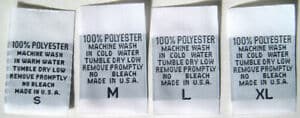I’ve been working with heat transfer vinyl a lot more lately since I’ve gotten a heat press.
One of the problems I’ve had is knowing which materials are safe to use.
Polyester isn’t easy to work with like cotton, but it’s not as difficult as you might think.
I’ve made a fair amount of mistakes while learning how to work with HTV on polyester, so let my experience keep you from making the same errors.
I usually like writing tutorials, but we’ll try something different here: I’ll just give you just the essential tips for how to use heat transfer vinyl on polyester.
There’s a lot of advice out there that doesn’t work, heat press settings for HTV which are just wrong, and tips which are confusing and contradictory.
I’m including only the advice that works!
Table of Contents
12 Tips for using HTV on polyester
If you’re wondering if you can use iron-on with polyester, the answer is yes! Absolutely!
If you want to save time, material, and some potential heartbreak, follow these tips:
Not all polyester is the same

Unlike cotton, polyesters can vary from garment to garment. Make sure to check your tag, and if you had success working with one kind of polyester shirt but not another, it could be that you’re working with a different material.
So if you’re on your 4th shirt and all of a sudden things get difficult, the HTV isn’t sticking, don’t fret! Take a look at the other tips and it’s likely one of them will fix your issue.
Don’t let your polyester get too hot
It’s better to start with a lower temperature and increase it later if you’re having trouble. HTV not sticking you can fix, but a scorched and discolored shirt you can’t fix.
If you check the heat application settings for most HTV, you’ll see that it’s actually a pretty low temperature, around 285°F.
Preheat your polyester

Unlike cotton fabrics, it’s preheating polyester won’t open up the fibers for your adhesive, but it does evaporate any water and smooth out the surface.
Working with a dry, smooth surface is essential for getting HTV that sticks once and doesn’t peel.
Know your material
It’s possible that what you thought was polyester is actually another material completely, and it doesn’t help that a lot of tags provide erroneous information. It’s also possible you’re using a cotton-poly blend and not 100% polyester.
If you’re working with a mix of synthetic and natural materials, it’s always better to start cooler and work your way up. Instead of higher heat, try a longer press time, which takes us to…
Increase how long you press it for
The activation temperature of the adhesive in your HTV is much lower than in polyester fabric. The way to make sure you don’t damage your material is instead of using a higher temperature, just increase how long you press the fabric for.
There isn’t really a downside in pressing for a shorter amount of time, checking, and then repressing if it’s not adhering correctly. It is better to get it right the first time, so make sure you have a good bond before throwing anything into your washing machine.
Test your fabric
If you’re working with a large batch of shirts or material, try to do a small test before committing to a larger project. Cut off a small swatch of polyester, heat press your iron on to the polyester, and run it through the washing machine a few times to see if it adheres.
You can even test before you decide which vinyl to use, just apply a heat press or iron at different temperatures to your polyester and see if it discolors or not. This way for each fabric you know the limitations, and you’ll quickly notice if something is different with a new batch!
Choose the right heat transfer vinyl
One of the biggest mistakes you can make is trying to work with a low-quality vinyl. The easiest HTVs to work with unfortunately aren’t the cheapest, but I wrote up a great guide on finding the right heat transfer vinyl for each project.
In short, you want an HTV that has a strong adhesive, is durable enough to withstand being worn and washed, and which comes in a variety of finishes. I don’t recommend switching between different brands for different looks, so find one that has enough versatility for every occasion.
Working with just one type of HTV means you won’t have to keep track of different settings for each brand, which saves me a lot of mental space!
Make sure the dyes don’t bleed from your fabric
If you’re working with a sublimated fabric, you need to be careful about applying heat transfer vinyl because the pattern from the shirt can leak into the vinyl. Standard HTV isn’t designed to block sublimation migration, so if you find that your vinyl keeps changing colors when you apply it to colorful fabrics, this might be your problem!
If you aren’t sure if your fabric was made using dye sublimation or not, check the other side of the fabric. If it’s a solid color, it’s likely your fabric was made using dye sublimation. If it goes through to the other side, you should be safe!
If you are using a fabric made with dye sublimation, don’t fret! Most brands (including my favorite) comes in a “sub-block” variety, which is designed to stop the garment from bleeding.
This is what I meant earlier by choosing a single brand of vinyl that can cover all of your needs!
Check if your fabric is heat sensitive
If your fabric is waterproof or even a certain blend of polyester, it might be marked on its tag as heat sensitive or “do not iron” — for this material you need to get a variety of HTV which is designed for releasing its adhesive at a lower temperature.
Don’t use a thick silicone sheet
Heat press pillows or silicone sheets are great for working with unusual materials that have a lot of irregularities like buttons or zippers, but for a flat material, they can add a lot of guesswork to getting the right temperature and pressure.
If you do want to use a sheet, a thin Teflon sheet is best, they’re the same ones that are designed to protect your heat press from vinyl sticking to it.
Use the right settings
This one might seem a bit obvious, but make sure you read the instructions that came with your vinyl! If you’re following a heat press tutorial and find that things aren’t going just right, it might be that you’re using a different brand than they are.
Similarly, if you aren’t working with pure polyester fabric, your settings for pressure, temperature, and time will differ.
Since I love working with Siser, I just printed out their cut settings and application settings.
Use a heat press, not an iron
The more precise you are with crafting, the better the outcomes you’ll have. This especially applies to heat-sensitive materials.
A lot of people think for some reason you can’t heat press polyester: you totally can and should!
With a heat press, you can exactly control how much heat you expose your material to and for how long.
Using an iron on polyester with HTV is fine for getting started, but if you’re having issues, that’s one of the first things I’d try changing.
If you do use an iron, make sure to set it to medium heat and turn any steam functions off.




